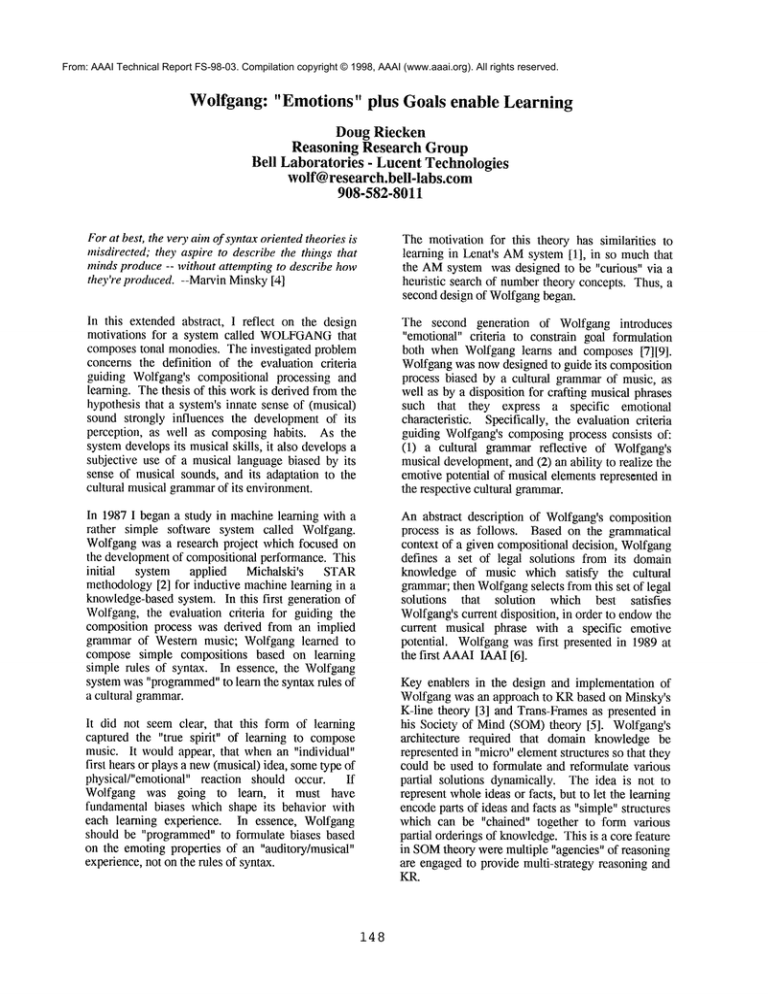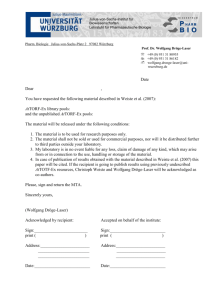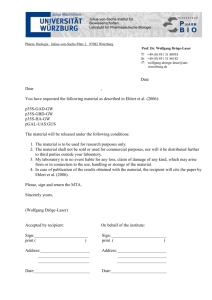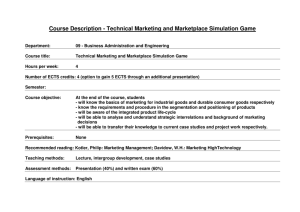
From: AAAI Technical Report FS-98-03. Compilation copyright © 1998, AAAI (www.aaai.org). All rights reserved.
Wolfgang: "Emotions" plus Goals enable Learning
DougRiecken
Reasoning Research Group
Bell Laboratories- LucentTechnologies
wolf@research.bell-labs.corn
908-582-8011
Forat best, the very aimof syntax oriented theories is
misdirected; the), aspire to describe the things that
minds produce -- without attempting to describe how
the),’re produced. --Man’in Minsky[4]
The motivation for this theory has similarities to
learning in Lenat’s AMsystem [1], in so muchthat
the AMsystem was designed to be "curious" via a
heuristic search of numbertheory concepts. Thus, a
second design of Wolfgangbegan.
In this extended abstract, I reflect on the design
motivations for a system called WOLFGANG
that
composestonal monodies. The investigated problem
concerns the definition of the evaluation criteria
guiding Wolfgang’s compositional processing and
learning. The thesis of this workis derived from the
hypothesis that a system’s innate sense of (musical)
sound strongly influences the development of its
perception, as well as composing habits. As the
systemdevelops its musical skills, it also develops a
subjective use of a musical language biased by its
sense of musical sounds, and its adaptation to the
cultural musical grammarof its environment.
The second generation of Wolfgang introduces
"emotional" criteria to constrain goal formulation
both when Woffgang learns and composes [7][9].
Woffgangwas nowdesigned to guide its composition
process biased by a cultural grammarof music, as
well as by a disposition for crafting musical phrases
such that they express a specific emotional
characteristic. Specifically, the evaluation criteria
guiding Woffgang’s composingprocess consists of:
(t) a cultural grammar reflective of Wotfgang’s
musical development,and (2) an ability to realize the
emotive potential of musical elements represented in
the respective cultural grammar.
In 1987 I began a study in machinelearning with a
rather simple software system called Wolfgang.
Wolfgang was a research project which focused on
the development of compositional performance. This
initial
system applied Michalski’s
STAR
methodology[2] for inductive machinelearning in a
knowledge-basedsystem. In this first generation of
Wolfgang, the evaluation criteria for guiding the
composition process was derived from an implied
grammar of Western music; Wolfgang learned to
compose simple compositions based on learning
simple rules of syntax. In essence, the Wolfgang
system was "programmed"
to learn the syntax rules of
a cultural grammar.
An abstract description of Wolfgang’s composition
process is as follows. Based on the grammatical
context of a given compositional decision, Wolfgang
defines a set of legal solutions from its domain
knowledge of music which satisf3, the cultural
grammar;then Woffgangselects from this set of legal
solutions that solution which best satisfies
Wolfgang’scurrent disposition, in order to endowthe
current musical phrase with a specific emotive
potential. Wolfgangwas first presented in 1989 at
the first AAAIIAAI [6].
It did not seem clear, that this form of learning
captured the "true spirit" of learning to compose
music. It would appear, that when an "individual"
first hears or plays a new(musical) idea, sometype
physical/"emotional" reaction should occur. If
Wolfgang was going to learn, it must have
fundamental biases which shape its behavior with
each learning experience. In essence, Wolfgang
should be "programmed"to formulate biases based
on the emoting properties of an "auditory/musical"
experience, not on the rules of syntax.
148
Key enablers in the design and implementation of
Wolfgang was an approach to KRbased on Minsky’s
K-line theory [3] and Trans-Fmmesas presented in
his Society of Mind (SOM)theory [5]. Wolfgang’s
architecUn-e reqnired that domain knowledge be
represented in "micro" element structures so that they
could be used to formulate and reformulate various
partial solutions dynamically. The idea is not to
represent wholeideas or facts, but to let the learning
encodeparts of ideas and facts as "simple" structures
which can be "chained" together to form various
partial orderings of knowledge.This is a core feature
in SOMtheory were multiple "agencies" of reasoning
are engaged to provide multi-strategy reasoning and
Kit
This architectural design was applied due to the
necessity that Wolfgang’sontology support extreme
fluid representations of knowledge. Thus, Wolfgang,
over time could learn new ideas, versus the classic
problem of the "plastic expert system". Wolfgang
had the ability to change its "behavior". Consider
the composer who lived for the first 30 years of
his/her life in Brooklyn, NYand then for the next 12
years in South America. Clearly, the fluidity of the
humanmind enables such a composerto evolve to a
new style of composingbehavior possibly influenced
by being immersedin a "different" culture; such is
the requirement of a composing learning system
guided by its "emotional" experiences. (Note:
Wolfgang’s architecture was later extended to
develop a multi-strategy reasoning system based on
SOMtheory which performed recognition
and
classification tasks supporting individuals in a
collaborative desktop conferencing system[8])
The Wolf gang architecture based on an interpretation
of K-line theor5,, enabled the implementation of
fundamental "emoting" biases representing
Wolfgang’sinitial sensation of sound and later its
learning and perception of "musical sounds" and
knowledge along with their respective emoting
potentials.
It was necessar5, that the emoting
potentials be represented in a dynamic K-line
network so that they would assert Wolfgang’s
"emotional" disposition
towards the
current
composingtask and/or learning experience.
Intelligence, R. Davis and D. Lenat (eds.), McGrawHill, NewYork.
[2] Michalski,
ILS., 1983. A Theory and
MethodoloD, of Inductive Learning". In Machine
Learning, ILS. Michalski, J.G. Carbonell, and T.M.
Mitchell (eds.), MorganKaufmann,Los Altos, CA..
[3] Minsky, M., 1980. K-Lines: A Theors, of
Memors,.In Cognitive Science Journal, 4, No. 2.
[4] Minsky, M., 1981. Music, Mind, and Meaning.
A.I. MemoNo. 616, Artificial
Intelligence
Laboratory, M1T,Cambridge, Massachusetts.
[3-] Minsky, M., 1985. Society of Mind. Simon &
Schuster, NewYork.
[6] Riecken, D., 1989. Goal Formulation with
Emotional Constraints: Musical Composition by
Emotional Computation. In AAAIProceedings First
Annual Conference on Innovative Applications of
Artificial
Intelligence,
Stanford University,
AAAI/MIT
Press: Cambridge, Massachusetts.
[7] Riecken, D., 1992. WOLFGANG:
A System
Using EmotingPotentials to ManageMusical Design.
In UnderstandingMusicwith Artificial Intelligence
Perspectives on Music Cognition, Balaban, M.,
Ebcioglu, K., and Laske, O. (eds.), AAAI/MIT
Press:
Cambridge, Massachusetts.
Wolfgang provided a working model of music
coinposition in which"dispositions" are instrumental
in deciding about steps in the elaboration of tonal
monodies. The research and design of Wolfganghas
resulted from a subjective view of musical composing
according to which the emoting potential of high
level musical constructs is more important to the
musical logic of a monodythan are their syntactic
features. A musical composition is thought to be an
artifact which stimulates the senses and cognitive
awareness of both its creator and any intended
listener. I therefore view composingas a process that
creates an artifact to communicatesome cognitive
"emotional" effect.
The composing process
necessitates the development of a set of musical
skills, and the application of these skills basedon the
disposition of the composer. Wemight consider
Wolf gang’s compositional processing as constrained
by its cultural grammar,and guided by its disposition
to musically comnmnicatesome emoting quality.
References
[1] Lenat, D., 1981. AM:AnArtificial Intelligence
Approachto Discover5, in Mathematicsas Heuristic
Search. In Knowledge-BasedSystems in Artificial
149
[8] Riecken, D., 1994. M: An Architecture of
Integrated Agents.
Special Issue of the
Communicationsof the ACMon Intelligent Agents,
D. Riecken (guest ed.), July 1994, Vol. 37, No.
ACM:New York, New York.
[9] Riecken, D., 1995. Wolfgang: "Emotions" and
Architecture
Which Bias Musical Design. In
Leonardo, Vol. 28, No. 3. MITPress: Cambridge,
Massachusetts.







